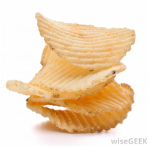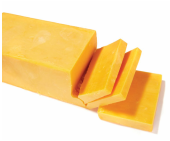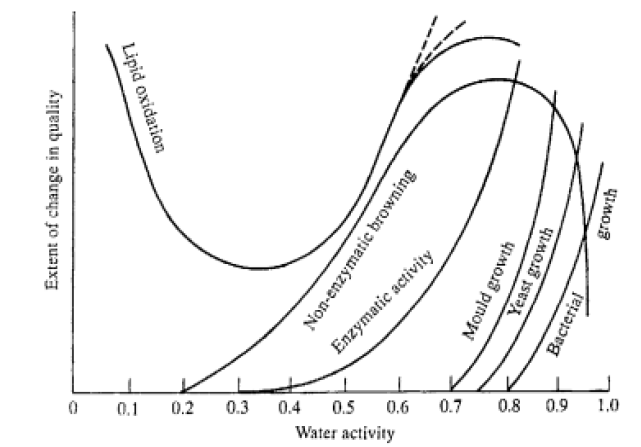The concept of aw has been very useful in food preservation and on that basis many processes could be successfully adapted and new products designed. Water has been called the universal solvent as it is a requirement for growth, metabolism, and support of many chemical reactions occurring in food products. Free water in fruit or vegetables is the water available for chemical reactions, to support microbial growth, and to act as a transporting medium for compounds. In the bound state, water is not available to participate in these reactions as it is bound by water soluble compounds such as sugar, salt, gums, etc. (osmotic binding), and by the surface effect of the substrate (matrix binding). These water-binding effects reduce the vapour pressure of the food substrate according to Raoult’s Law. Comparing this vapour pressure with that of pure water (at the same temperature) results in a ratio called water activity (aw). Pure water has an aw of 1, one molal solution of sugar - 0.98, and one molal solution of sodium chloride - 0.9669. A saturated solution of sodium chloride has a water activity of 0.755. This same NaCl solution in a closed container will develop an equilibrium relative humidity (ERH) in a head space of 75.5%. A relationship therefore exists between ERH and aw since both are based on vapour pressure.
The ERH of a food product is defined as the relative humidity of the air surrounding the food at which the product neither gains nor loses its natural moisture and is in equilibrium with the environment.
Minimum Water Activity Limit
Minimum aw values for growth and toxin production by microorganisms of public health concern. Some general information as follow:
- Critical aw for most foods: 0.6 – 0.7.
- Pathogenic bacteria inhibited < 0.85 – 0.86.
- Yeast and mould are more tolerant at < 0.80, but no growth below the aw < 0.6.
Measurement method:
- Equilibrium sorption rate
- Vapour pressure measurement
- Hygrometric instrument
- Indirect/predictive method
Factors Affecting Water Activity
Food components
•Protein and starch adsorb much more water at low aw than do fatty or crystalline substances (ex. sugar).
Physicochemical state of food components
•Many food components may be present in several states: crystalline solids, amorphous solids either rubbery or glassy , aqueous solution, or bound to other components.
The ERH of a food product is defined as the relative humidity of the air surrounding the food at which the product neither gains nor loses its natural moisture and is in equilibrium with the environment.
Minimum Water Activity Limit
Minimum aw values for growth and toxin production by microorganisms of public health concern. Some general information as follow:
- Critical aw for most foods: 0.6 – 0.7.
- Pathogenic bacteria inhibited < 0.85 – 0.86.
- Yeast and mould are more tolerant at < 0.80, but no growth below the aw < 0.6.
Measurement method:
- Equilibrium sorption rate
- Vapour pressure measurement
- Hygrometric instrument
- Indirect/predictive method
Factors Affecting Water Activity
Food components
•Protein and starch adsorb much more water at low aw than do fatty or crystalline substances (ex. sugar).
Physicochemical state of food components
•Many food components may be present in several states: crystalline solids, amorphous solids either rubbery or glassy , aqueous solution, or bound to other components.
Food Stability Diagram
Additional reading materials:
| Water Activity and Food Preservation | |
| File Size: | 420 kb |
| File Type: | |
| Water Activity and its Measurement in Food | |
| File Size: | 527 kb |
| File Type: | |



